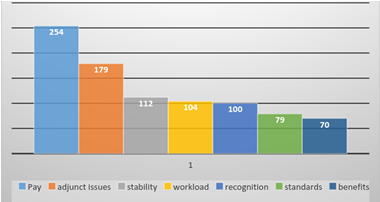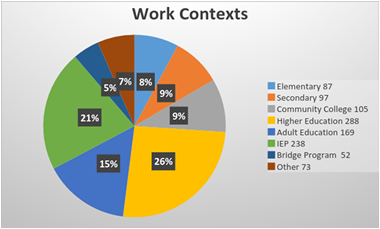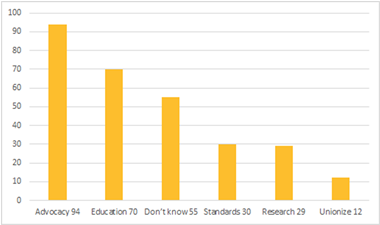|
 To provide current and future TESOL leaders with concrete and critical information regarding employment issues in its final year, the TESOL Employment Issues Committee (EIC)* designed and conducted a survey among TESOL members in August 2015. The survey was distributed through TESOL interest sections, committees, and affiliates, but was open to nonmembers as well. There were a total of 724 respondents, over 80% of whom were native English speakers. The majority of respondents had an MA degree in TESOL or a related field, and over 40% had 15 or more years of experience. To provide current and future TESOL leaders with concrete and critical information regarding employment issues in its final year, the TESOL Employment Issues Committee (EIC)* designed and conducted a survey among TESOL members in August 2015. The survey was distributed through TESOL interest sections, committees, and affiliates, but was open to nonmembers as well. There were a total of 724 respondents, over 80% of whom were native English speakers. The majority of respondents had an MA degree in TESOL or a related field, and over 40% had 15 or more years of experience.
Survey results indicate that there are persistent employment issues to which the organization needs to pay more close attention, and in January 2016, the committee submitted a report of the findings and recommendations to the TESOL Board of Directors. The following is a brief overview of the survey and report.
Current Employment Issues
The first of two main questions in the survey asked respondents to list their top three employment concerns. The responses were categorized into one of the seven categories shown in Figure 1.

Figure 1. Top three employment concerns
Pay
By far, the most common concern was low pay. Most comments stated that teacher pay was too low, while some mentioned that pay was low considering required qualifications, or that pay did not cover preparation, administrative tasks, office hours, or overtime.
Adjunct Issues
The second most common concern focused on adjunct issues. On this topic, the biggest concern was that there are few full-time positions available compared to part-time positions. Some comments mentioned possible reasons, such as institutions not wanting to pay benefits. Several respondents also mentioned that part-time faculty were mistreated or overused.
Job Stability
The third most common theme was job stability. Although most comments in this group were fairly short and stated just that stability was a problem, a subgroup of 10 comments pointed out that contracts were often short term or nonexistent.
Other
In the remaining comments, various concerns were identified, the most common being heavy workloads, lack of recognition, problems with standards, and insufficient or nonexistent benefits. With respect to standards, most comments related to teacher qualifications, not standards for students.
To understand why some issues may be considered more critical than others, the respondents were asked to identify their teaching contexts. The breakdown is shown in Figure 2.

Figure 2. Work contexts
Suggestions by Respondents
In addition to stating their greatest employment concerns, respondents were also asked what they thought TESOL, as an organization, could do to address these concerns. The chart shown in Figure 3 displays their responses. It should be noted that while the survey sought to identify issues across contexts (both ESL and EFL), responses from EFL settings were significantly lower than those from ESL settings, and thus it was difficult for the committee to gain a better insight into issues pertinent to EFL settings. There were also a low number of responses addressing particular employment-related issues for nonnative-English-speaking teachers.

Figure 3. How can TESOL International Association address issues?
Advocacy
Survey respondents clearly wanted TESOL to do more to advocate for the field, including in the areas of higher pay and working conditions, and to do so at the local, state, and federal levels. Some respondents also mentioned the need to educate the public on the role of English language teachers.
By far, part-time, adjunct, and contingency instructors constitute the largest population for whom respondents wanted TESOL to advocate, especially for better pay and more full-time positions. There were, however, only a few specific recommendations on how to advocate for this population. These include providing support groups, creating training opportunities to teach ELT program administrators to advocate for more full-time teachers, and forming partnerships with other organizations that support adjuncts, as well as part-time and contingency teachers.
Education
Respondents in this section offered two primary sets of recommendations. The first was that TESOL provide more affordable professional development (PD) opportunities for teachers, including more online offerings. The second set of recommendations mirrors those in both the research and advocacy categories; in other words, respondents wanted TESOL to provide more PD opportunities for administrators. Here, the primary concern appears to be that administrators above the program level do not understand the knowledge and skills English language teachers need to be effective and successful teachers. As such, many English language teachers feel that they do not receive the respect they deserve or the resources they need.
Don’t Know
That many didn’t feel that they knew what TESOL could possibly do for them, the third highest response in the survey findings, seems to point toward an interesting and important question: How can TESOL work with its members to identify and, equally important, address those employment issues that have tangible and meaningful consequences for the ELT profession, including teachers, administrators, and students?
Standards
A number of respondents pushed for some kind of standards for ESL professionals, but there was not consensus on what those standards should be or to whom they should apply. Once again, this group identifies a need to provide administrators with information on the roles and value of ELTs and the knowledge, skills, and other qualifications they need to be successful.
Research
There were two primary sets of recommendations in the research category.
The first was that TESOL should sponsor research on the proliferation, pay, and working conditions of part-time, adjunct, and contingent ESL teachers (in the U.S. and in EFL settings), to disseminate the findings as widely as possible and to lobby employers to hire more full-time teachers. The second was that TESOL should conduct research on teacher standards in order to advocate for ESL teachers to help their administrators understand the skills required to teach effectively. Both of these issues have been addressed above.
Unionize
This was the smallest category, with the overriding recommendation being that TESOL should support unionization for ESL teachers.
Recommendations
Based on the survey results and subsequent analysis, the EIC drafted recommendations for the TESOL board that included, but were not limited to:
- further developing and advertising the organization’s professional development opportunities.
- strengthening relationships with accrediting agencies.
- establishing standards on pay and workload.
- encouraging research on employment issues.
- providing resources on unionization.
Conclusion
As can be clearly seen in the survey findings, the scope of employment issues in the field of ELT is wide-ranging and not something one committee alone can address. Instead, the committee included in its recommendations that TESOL continue to work with its constituents to research pertinent employment-related issues and trends, and to identify appropriate courses of action that would best serve the membership moving forward. With the data from the survey and recommendations offered in the report, the committee hopes to have informed the board’s decisions on any employment-related issues that TESOL may want to address as it celebrates 50 years of as a professional organization.
Reader Takeaways: What Does This Mean for You?
As many readers may have noticed already, the concerns raised in the EIC survey and report are not new to the field of English language teaching. In fact, some persistent issues are as old as or older than the organization itself. Many issues persist because they are complex and often politically (and otherwise) intertwined with other issues, making them difficult to tackle.
With that said, many of the concerns manifest locally: in your institution, organization type (IEP, community college, K–12, etc.), or geographical location. True, you might not be able to address all of them (or any of them) on your own, but if you join forces with other colleagues, you might be able to address the ones that are most important to you. Talk to other educators in the same institution, institution type/teaching context, or location. Ask what others are doing to bring awareness to their issues and promote their needs. Connect via your TESOL affiliate or primary interest section. Be informed about the issues that affect you, and don’t be afraid to ask your fellow educators for support.
We as the committee strongly believe that information and a strong network are two of the most vital tools in addressing any employment issue.
*The EIC was dissolved as of December 2015 as part of a governance restructuring.
Amy Pascucci, MA TESOL, has taught in the United States in secondary, postsecondary, adult education, intensive English programs (IEPs), and teacher training programs. Amy was an English Language Fellow in Cairo at Al-Azhar University. She currently resides in California teaching in an IEP, and was the 2015 chair of the TESOL Employment Issues Committee.
Steven Humphries is an associate professor of TESOL and director of ESL at Shenandoah University in Winchester, Virginia. He has been an ESL teacher, teacher trainer, and administrator in the United States, South Korea, and Panama. His professional interests include intercultural communication, language assessment, and program administration. He is past chair of the Employment Issues Committee.
Heather Robertson, EdD, taught ESL for more than 35 years at the adult, community college, and university levels before retiring in 2015. She most recently taught in the University of Southern California MS TESOL program and intensive English program. She is a past chair of the TESOL Higher Education Interest Section.
Kyung-Hee Bae is the associate director of the Center for Written, Oral, and Visual Communication at Rice University. Her academic and research interests include writing in the disciplines, second language writing, writing pedagogy and theory, genre theory and analysis, and writing center theory and practice. |